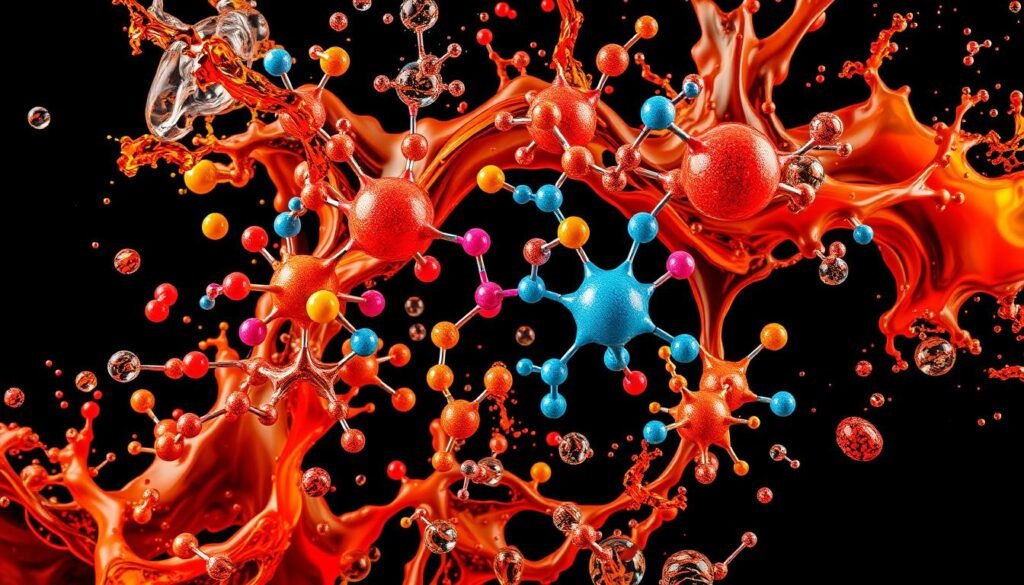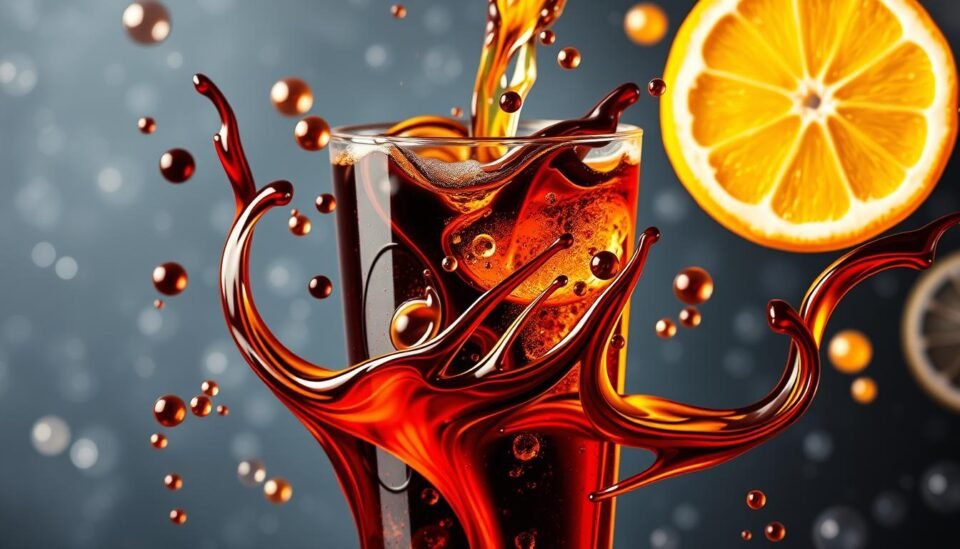Cola is a beloved soft drink enjoyed worldwide. Its distinct flavor is a captivating mix of tastes.
This guide explores cola’s unique taste and key ingredients. We’ll uncover the science behind its iconic flavor.
Cola’s flavor comes from a blend of botanicals, citrus, and spices. This mix creates a cola flavor profile that people love.
Let’s dive into the secrets of this iconic beverage. We’ll discover what makes each sip so enjoyable.
Understanding the Basics of Cola Flavour
Cola’s unique taste comes from a mix of special ingredients. Carbonated water gives it a refreshing fizz. Sweeteners like sugar balance out the bubbles.
Each brand uses its own secret blend of flavors. These often include citrus, spices, and botanicals. The mix creates a taste that cola fans love.
The key parts of cola are carbonated water, sweeteners, and flavors. These elements work together to make cola’s complex taste.
Knowing these basics helps us explore cola’s history and trends. It also helps us understand why people enjoy it so much.
Historical Overview of Cola Flavours
Cola flavor began in the late 19th century. It came from the kola nut, a fruit from West Africa.
The cola taste changed over time. Food science and consumer likes drove this change.
Coca-Cola and Pepsi became famous in the early 1900s. They made unique cola flavors using spices and herbs.
Cola flavors kept changing through the 20th century. Soda companies wanted to please customers and beat rivals.
New cola types came out over time. These included cherry, vanilla, and citrus flavors.
Diet and zero-sugar colas also became popular. People wanted healthier drinks with fewer calories.
Cola flavors show how creative the soft drink industry is. They keep making new tastes for people to enjoy.
Tasting Notes of Different Cola Brands
Cola brands offer unique flavor profiles that delight taste buds. Let’s explore the differences between Coca-Cola, Pepsi, and RC Cola.
Coca-Cola blends sweetness and carbonation for a crisp, refreshing taste. It features vanilla and caramel notes with a hint of citrus.
Pepsi has a bolder sweetness with a more intense, fruity flavor. It’s often described as having a stronger taste than Coca-Cola.
RC Cola has a more subtle flavor with less sweetness. It stands out with pronounced caramel notes and a hint of spice.
These flavor differences shape brand identities and fan loyalties. Cola lovers often pick favorites based on these unique taste profiles.
Exploring cola flavors can be a fun taste adventure. You might discover a new favorite among these iconic brands.
The Science Behind Cola Tastes
Cola’s flavor comes from a mix of chemical compounds. Flavor chemistry studies these compounds and how they affect taste.
Essential oils like citrus and vanilla create cola’s unique taste. These oils work with our taste buds to make flavors.

Sensory analysis looks at how we understand flavors. It explores what affects our cola experience.
Carbonation gives cola its refreshing feel. The mix of sweet, bitter, and sour creates a balanced taste.
Copying cola’s taste is hard for flavor scientists. The complex mix of ingredients makes it tricky.
As flavor chemistry grows, new ways to capture cola’s taste may appear.
Popular Cola Cocktail Recipes
Cola-based cocktails offer a fun twist on classic mixed drinks. They blend the iconic cola flavor with various spirits and mixers.
The Cuba Libre is a well-known cola cocktail. It mixes rum, cola, and lime for a sweet and tangy taste.
The Long Island Iced Tea is a stronger cola-based drink. It combines vodka, tequila, rum, triple sec, and cola for a smooth sip.
Modern cola cocktails include Bourbon and Cola or Spiced Rum and Cola. These drinks highlight cola’s taste while complementing the spirits’ flavors.
Try different brands and ratios to find your favorite cola cocktail. You’ll discover new and exciting flavor combinations to enjoy.
Exploring Cola Flavours Around the World
Cola comes in many international varieties. Each one reflects unique regional tastes and cultural influences.
The global cola market has diverse international options. These colas often use local ingredients, spices, and botanicals.
This mix creates unique flavors for different markets. It has led to a vibrant global flavor landscape.
The cola world also offers limited-edition and experimental flavors. These new twists appeal to people who want adventure.
Tropical fruit colas and herbal variants are examples. The cola market keeps changing to meet diverse tastes.
International colas tell stories of culture and tradition. They also show how cola keeps changing.
This look at global colas quenches our thirst. It also teaches us about this popular drink.
The Future of Cola Flavours
Cola flavours are changing to meet new health trends. Soft drink companies are making less sugary drinks with natural ingredients.
Coca-Cola’s Y3000 Zero Sugar is a new soda made with AI. It shows how flavor innovations are meeting changing tastes.
Future colas may have extras that do more than refresh. They might blend bold tastes with health benefits.
Cola makers must balance health trends and what people want. Brands that make new, useful cola drinks will do well.
How to Make Your Own Cola
Want to make your own cola? It’s fun and easy! You can create a unique drink that suits your taste buds.
You’ll need a few key ingredients and tools. The main part is a flavorful cola syrup.
You can make syrup with cane sugar, caramel coloring, and spices. Next, carbonate your drink using a soda maker or club soda.
Try different flavor combos or make a caffeine-free version. The options are endless!
Making cola lets you control what’s in your drink. You can get creative and make something truly special.
Try crafting DIY soft drinks to quench your thirst. Impress your friends with your new skills.
Start your homemade cola adventure today! You’ll love the results.
